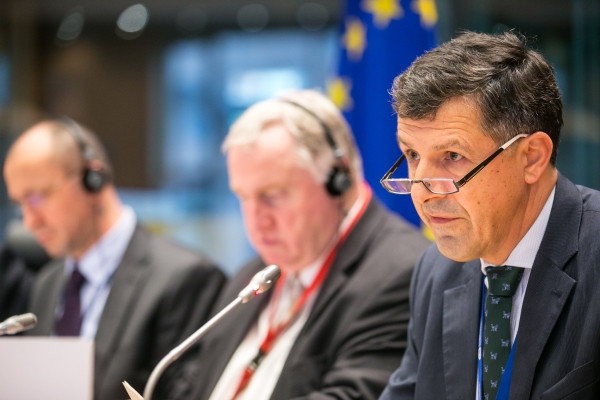Europe's Local and regional authorities explain their territorial vision in a report prepared by Oldřich Vlasák

During its 115th plenary session, the Committee of the Regions adopted the report on "Territorial Vision 2050: What future?", prepared by Oldřich Vlasák (CZ/ECR). Welcoming the Luxembourg Presidency efforts to launch a discussion on a Territorial Vision for the year 2050, the report called for a stronger bottom-up approach to EU policies and for existing funds and policies to be streamlined and simplified.
"We are pleased that the Luxembourg Presidency has got the ball moving and consulted local and regional authorities on this important matter. I am especially pleased to see our opinion and key messages being referred to in the Conclusions of the Informal Ministerial Meetings on Territorial Cohesion and Urban Policy. It is now time for a Europe wide consultation to look concretely at how we can make better use of local and regional data to guide EU policies and help them achieve greater impact" said Mr Vlasák.
Mr Vlasák underlined that territorial cohesion remains a challenge and that a stronger bottom-up approach led by local and regional data is needed to help achieve more balanced growth and development. "Article 174 of the Treaty on the Functioning of the EU sets the overarching objective for the harmonious development of the Union. To ensure this is achieved, we need to make sure that our regions that already suffer from severe and permanent natural or demographic handicaps such as the northernmost regions with very low population density and island, cross-border and mountain regions are not left behind" said Mr Vlasák.
Rapporteur Vlasák's report highlights that a clear European territorial vision is necessary in order to respond effectively to current and future trends and challenges. This vision should strengthen the territorial dimension in policy-making by using a results-oriented territorial dialogue and the expertise of local and regional authorities to identify and address the key territorial challenges of the European Union. The rapporteur underlined that "we need to use local and regional experiences to shape EU policies. The territorial vision should provide guidance to all EU policies that have a territorial dimension." The report underlines that a territorial vision needs to be used to help shape the post-2020 period for EU Funds.
"A bottom-up approach would mean shaping EU policies based on local and regional realities. Our local and regional authorities would therefore also have a greater say in the design and management of European projects and policies," said Mr Vlasák. The report underlines the need for Europe 2020 (EU's growth strategy) to be shaped bottom-up so that the targets better account for the local implications they have. Mr Vlasák explained that "Europe 2020 is an excessively technocratic and top-down exercise. The targets are in many cases the responsibility of local and regional government yet they are developed with very little contribution from us."
To help build policies from the bottom-up, the CoR calls for greater involvement of local and regional authorities and greater investment in data. "We need data from cities and regions to reinforce the territorial approach in policy-making", said Mr Vlasák. He requested Member States and the European Union to invest in acquiring the missing statistical data and develop simple data collection methods at the lowest administrative level without creating additional administrative burdens. "We really do need to decrease the administrative burden connected with collection of statistical data and reporting" Mr Vlasák emphasised. This is particularly important in those countries where Eurostat territorial units do not really reflect real geographies at local or regional level. Without a complete and evolving picture of the European Union's regions, it is not possible to create effective policies that address the challenges they face.
Furthermore, the Member States and the European Union need to implement Territorial Impact Assessments as a standard practice in the policy-making process. If the possible asymmetric effects of the EU and national policies are not taken into account, these policies can never be sufficiently efficient or effective, potentially resulting in unwanted effects. The report also draws attention to the advantages and benefits of applying the place-based approach and collaborative policy-making approach, whose essential elements concern the integration of sectors in a particular territorial strategy and a results-oriented territorial dialogue. If implemented effectively, the place-based approach makes it possible to value and revive territorial identity and territorial specificities as a unique asset.
Mr Oldřich Vlasák (Councillor of Hradec Králové, Czech Republic/ECR Group Vice-President) is the Committee of the Regions’ rapporteur on “Territorial Vision 2050: what future?”. This opinion was discussed and adopted unanimously at the 3 December Committee of the Regions Plenary Session. Mr Oldřich Vlasák is the former Vice-President of the European Parliament responsible for the European Parliament’s relations with the Committee of the Regions. During his Vice-Presidency, the two institutions concluded a cooperation agreement that outlined areas under which EP-CoR cooperation would be deepened. He was among the first Czech members appointed to the Committee of the Regions as an observer in 2000 prior to being elected as an MEP in 2004. He is now a member of the Committee of the Regions and Vice-President of the ECR Group in the CoR.

